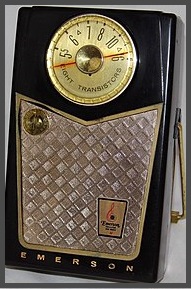 Spotify link: Groove Music School Playlist – The 60s (Opens Spotify App)
Spotify link: Groove Music School Playlist – The 60s (Opens Spotify App)
Check out the 60s playlist I put together for Groove Music School. It has more than 230 songs, including many hits from the Motown record label. Put it on shuffle, and it gives you a good idea of what the golden age of AM rock radio sounded like. It has most of the songs in the Time/Life 60s CD set.
This is the rock side of AM, no bubblegum. No Herman’s Hermits or Bobby Goldsboro. It includes deep cuts, hit records that have been largely forgotten for whatever reason. A few songs songs released as singles are from the early days of FM rock, when they were still competing with AM.
There was an explosion of music in the 1960s compared with previous decades. The 1960s produced an avalanche of recorded music, especially in the late 60s, after the first “British Invasion.”
The glory days of AM radio started when the first small, mass-market transistor radios came out in 1957, a little before my time. That’s two years after the birth of rock-n-roll with Bill Haley and the Comets’ record “Rock Around The Clock.”
Transistor radios were popular through the end of the 1960s, when many music listeners switched to FM. AM remained popular, because FM radios weren’t standard in most car models until the late 1970s, and this was a time when people spent a lot of time in their cars. Most people listening to AM today are listening in their cars.
The golden age of AM rock radio was dominated by two major radio stations: WABC in New York City, and WLS in Chicago, from about 1960 to 1968. That’s when rock emerged on FM. These two stations were the trendsetters for radio programmers nationwide.
Because of the flat topography of most of the US, WLS’s 50,000-watt signal could be heard for hundreds of miles in all directions. Programmers in distant cities didn’t have to follow the Billboard charts or the industry trades to keep up with what they were playing. And radio programmers in other cities were listening. In Dallas in the 60s and 70s, we could pick up WLS loud and clear on our car radios after dark.
1960s “greatest hits” playlists are just about all the same. There were some regional hits. But from traveling cross country by car in the 1960s, rock radio was mostly the same wherever you went. The 1970s, and the beginning of FM rock radio is where stories start to diverge.
FM is better for music than AM because the sound quality is better. Also, FM doesn’t pick up the intermittent static you get with AM. You don’t hear much static during thunderstorms on FM. You get lots of static on AM during storms. In the old days, people used AM radios to track which direction thunderstorms were coming from.
A few stations experimented with AM stereo. They were pushing it as late as the early 1980s. But people had to buy special AM radios, or use two different radios to tun in the left and right speaker signals. Not many people did. Also, the sound quality couldn’t match FM, so the idea never caught on.
In Dallas, the main AM rock station was KLIF, owned by Gordon McLendon, a true broadcasting pioneer. McLendon was an early player in the Top 40 radio format. It was invented by a guy who counted how many times kids would play particular songs on jukeboxes. He noticed when young people listened to jukeboxes, they played the same few songs over and over. McLendon was also an innovator in sports radio. He’s kind of a personal hero of mine. I’ll tell you more about this icon of Texas radio, and how the sale of KLIF led to the creation of its more successful “heavy sister,” KNUS-FM.